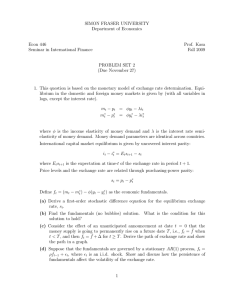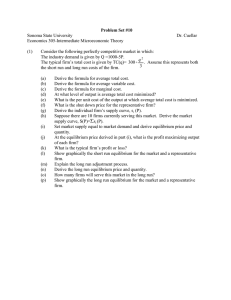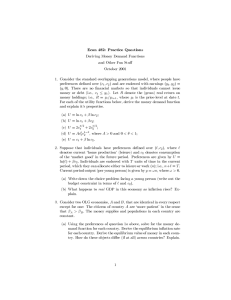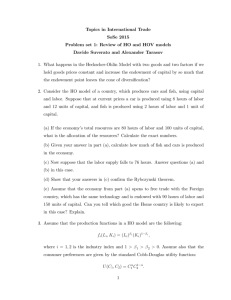SIMON FRASER UNIVERSITY Department of Economics Econ 808 Prof. Kasa
advertisement
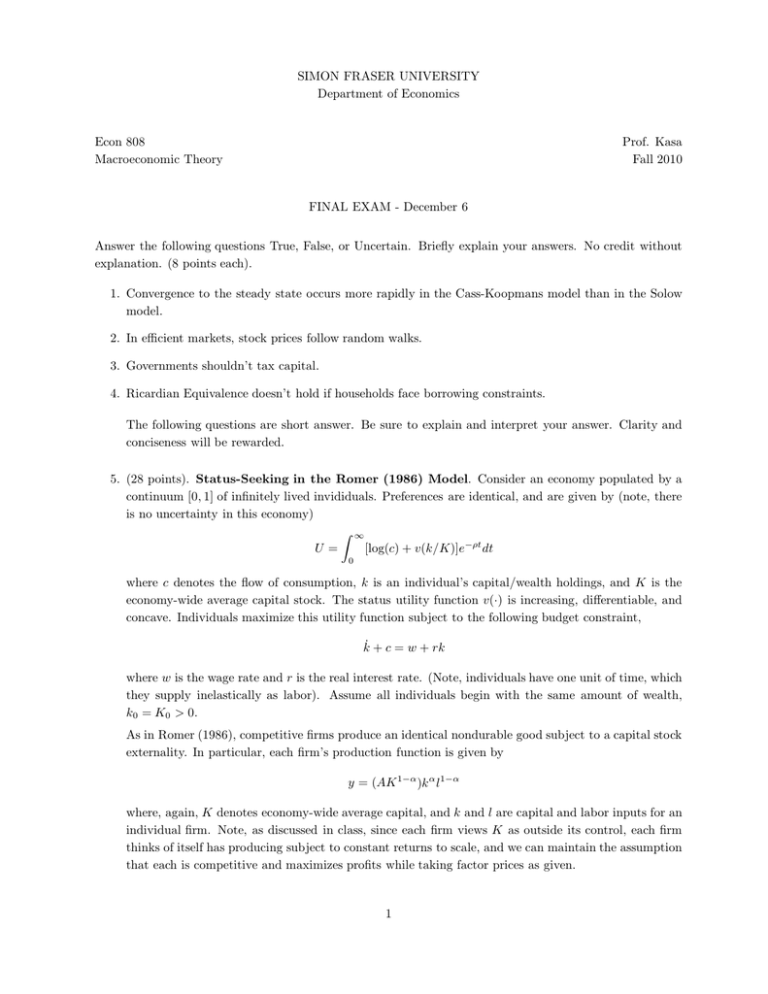
SIMON FRASER UNIVERSITY Department of Economics Econ 808 Macroeconomic Theory Prof. Kasa Fall 2010 FINAL EXAM - December 6 Answer the following questions True, False, or Uncertain. Briefly explain your answers. No credit without explanation. (8 points each). 1. Convergence to the steady state occurs more rapidly in the Cass-Koopmans model than in the Solow model. 2. In efficient markets, stock prices follow random walks. 3. Governments shouldn’t tax capital. 4. Ricardian Equivalence doesn’t hold if households face borrowing constraints. The following questions are short answer. Be sure to explain and interpret your answer. Clarity and conciseness will be rewarded. 5. (28 points). Status-Seeking in the Romer (1986) Model. Consider an economy populated by a continuum [0, 1] of infinitely lived invididuals. Preferences are identical, and are given by (note, there is no uncertainty in this economy) Z ∞ [log(c) + v(k/K)]e−ρt dt U= 0 where c denotes the flow of consumption, k is an individual’s capital/wealth holdings, and K is the economy-wide average capital stock. The status utility function v(·) is increasing, differentiable, and concave. Individuals maximize this utility function subject to the following budget constraint, k̇ + c = w + rk where w is the wage rate and r is the real interest rate. (Note, individuals have one unit of time, which they supply inelastically as labor). Assume all individuals begin with the same amount of wealth, k0 = K0 > 0. As in Romer (1986), competitive firms produce an identical nondurable good subject to a capital stock externality. In particular, each firm’s production function is given by y = (AK 1−α)kα l1−α where, again, K denotes economy-wide average capital, and k and l are capital and labor inputs for an individual firm. Note, as discussed in class, since each firm views K as outside its control, each firm thinks of itself has producing subject to constant returns to scale, and we can maintain the assumption that each is competitive and maximizes profits while taking factor prices as given. 1 (a) Impose the equilibrium conditions, k = K and l = 1 in the firm’s profit-maximizing hiring decisions, and derive expressions for the equilibrium wage and interest rate (in terms of A, K, and α). (Big Hint: Factor prices equal marginal products). (b) Write down the current value Hamiltonian that characterizes the individual’s optimization problem. Let λ denote the co-state variable, and derive the first-order conditions. (Hint: there should be one (algebraic) equation characterizing the optimal choice of c in terms of λ, an adjoint differential equation describing the evolution of λ in terms of ρ, r, k, and K, and a differential equation in k describing the budget constraint. (c) Using the answer in part (a) to eliminate r, and imposing the symmetric equilibrium condition k = K, derive an expression for the adjoint equation in which λ̇ only depends on λ, K, and v0 (1) (along with the underlying parameters, α, ρ, and A). Note that v0 (1) can be interpreted as the equilibrium marginal value of status. Denote this by s. (d) Next, let g denote the economy’s equilibrium balanced growth rate (i.e., g = Ẏ /Y = Ċ/C = K̇/K). Note that by differentiating the household’s first-order condition for c, we can then derive λ̇/λ = −g. Use the economy’s aggregate resource constraint, Y = C + K̇, to derive a simple expression for C in terms of K, A, and g. Use this expression to write λ in terms of K. (e) Finally, use these results in the adjoint equation to derive an expression for g in terms of s. How does the quest for status affect the economy’s equilibrium growth rate? Interpret your results. (g) As discussed in class, the standard Romer (1986) model produces a Pareto inefficient growth rate, due to the externality. What is the optimal growth rate (i.e., put yourself in the shoes of a social planner, and internalize the externality)? Derive an expression for s that offsets the production externality, so that status-seeking has the effect of producing an equilibrium growth rate that is Pareto optimal. (Note, this would be an example where two externalities exactly offset each other). 6. (20 points). News and the Stock Market. Consider a Lucas (1978) asset pricing model where the representative agent has preferences given by U = Et ∞ X j=0 βj c1−γ t+j 1−γ The agent can buy shares in a ‘tree’, which yields a stream nondurable fruit/dividends dt+j . In equilibrium, consumption equals dividends, which equals output, yt+j . Let Pt be the time-t (exdividend) share price (ie., the price after current period dividends have been paid, so that a current share purchase only entitles you to the stream of dividends starting next period). (a) Write down the agent’s Euler equation characterizing his optimal portfolio decision. (b) Impose the equilibrium condition, dt = yt , and derive a first order stochastic difference equation for Pt. (c) Iterate this equation forward and derive an expression for Pt in terms of yt and the expected present discounted value of future yt . (Impose the ‘no bubbles’ condition to rule out explosive prices). (d) Does ‘good news’ about future output always produce an increase in stock prices? Under what conditions on γ will this be the case? Interpret your results. 7. (20 points). Social Security in the Diamond (1965) Model. Consider an economy composed of overlapping generations of two-period lived agents. Population grows at rate n (i.e., Lt+1 = (1 + n)Lt ), 2 so that for each old person there are (1 + n) young persons. Each agent is endowed with one unit of labor when young, and cannot work when old. Hence, agents must save for their retirement by acquiring claims to capital. (There are no bequests). All agents have the same preferences, given by U = log(c1,t ) + 1 log(c2,t+1) 1+ρ where c1,t denotes consumption of the young at time-t, and c2,t denotes the consumption of the old at time-t. Agents maximize the above utility function subject to the following two budget constraints: c1,t + St = wt (1) c2,t+1 = (1 + rt+1 )St (2) where St denotes saving, and wt is the time-t wage rate. Note that individuals supply labor inelastically when young, and supply capital inelastically when old. (For simplicity, capital is assumed not to depreciate). Output is produced by competitive firms, who hire young workers and rent capital from the old agents. The production function is given by Yt = Ktα L1−α t Assume the economy begins with an initial generation of old people, who own the initial capital stock K0 . (a) Write down the market-clearing condition for the capital stock. (Hint: The supply of capital by the current old generation must equal the firm’s demand for it). (b) Let kt = Kt /Lt be the time-t capital/labor ratio. Use the answer in part (a) to derive a firstorder difference equation in kt describing the equilibrium capital stock dynamics in this economy. Derive an expression for the steady state capital stock. Is it unique? Stable? (c) Now suppose the economy is in a steady state, and the government establishes a ‘pay-as-you-go’ social security system, which involves levying (lump-sum) taxes, τ , on the young in order to finance transfers to the current old generation. Write down an agent’s budget constraints under this new policy. Solve for the agent’s optimal savings policy, St . (d) Under what conditions will this social security system produce a Pareto superior outcome (ie., make all generations better off)? That is, derive conditions on the exogenous parameters, ρ, n, and α that guarantee the program yields a Pareto improvement. Explain why the original competitive equilibrium was Pareto inefficient. (Hints: (1) Obviously, the old generation when the program begins always benefits, since they get transfers, but did not contribute taxes when they were young. Hence, it suffices to show that the first and all subsequent young generations benefit. (2) To do that, it suffices to show that their lifetime wealth (including taxes and transfers) increases. (3) Show that their wealth increases if n > r, where r is the initial steady state interest rate. (4) Hence, find parameter values that guarantee n > r). 3
